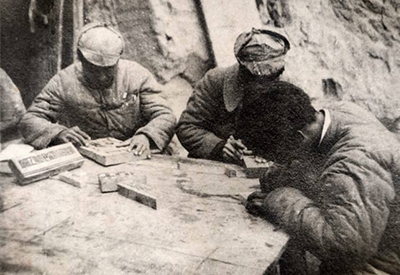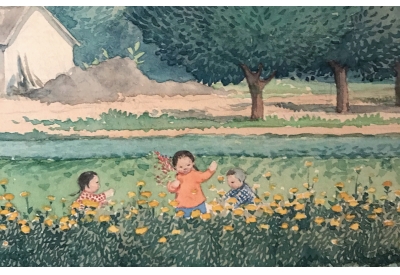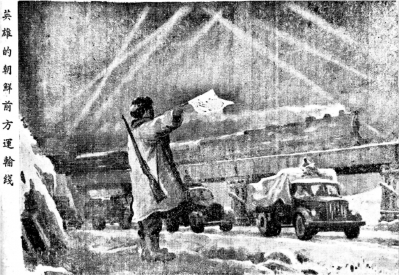Gu Yuan
1919-1996
Gu Yuan’s work is a social history of revolution and development in 20th century China: the construction of base areas, the War of Liberation, the Five-Year Plan, the Great Leap Forward…the magnificent historical narratives were depicted by Gu Yuan in his wood engravings and watercolor paintings in such a detail, that they were transformed into care about ordinary people. The political theme was thus transformed into a “lyric poetry” (Ai Qing).
In 1938, Gu Yuan arrived in Yan’an, and went to the third phase of Department of Fine Arts at Yan’an Lu Xun College of Art in the following year. In 1942, Mao Zedong published Talks at the Yan’an Forum on Literature and Art, in which he called for teachers and students of the Lu Xun College of Art to walk outside the “little college”, and spread the literature and art among the masses. Gu Yuan thus transformed many engraving forms and styles, including the intaglio method, which originated from Western Europe, into relief method that characterized Chinese folk New Year paintings and traditional Chinese wood carvings. He created many works with clear outlines, easy to understand for peasants, and of the spirit that “art serves the people”.
The combination of art career and the Party’s revolutionary cause is the character of many Yan’an artists. Both a soldier of the nation and an individual artist, they worked hard to balance between revolutionary narrative and individual expression, to create works that both match political ideology and are rich in artistic beauty. Such balance was demonstrated in Gu Yuan’s work through his observation of the local conditions and customs. Through sentiments and flavors of life, Gu blurred political ideology in his detailed depiction of real and unadorned social relationship.
After 1950s, due to the improvement of creative environment, and the artist’s belief that “colored image is more suitable for depicting the inner beauty of the working people”, Gu Yuan increased his watercolor painting creation. In these colorful yet plain landscape paintings, the portrayal of people still remained. In his Ink and Wash Paintings of Gu Yuan published in 1985, Gu wrote: “I rarely paint landscape paintings without people in it…Art comes from life. I always go into people’s life for interesting, healthy and positive subjects.”
Until his death in 1990s, Gu Yuan had been carrying on the simple creative style, as he believed that the art that reflects life and moves the society forward would always be new art. Such idea lasted for his life after he attended the Yan’an Forum on Literature and Art in 1942. Even today, Gu Yuan’s idea still inspires us to think about all kinds of questions about forms and functions of painting.
Gu Yuan’s work is a social history of revolution and development in 20th century China: the construction of base areas, the War of Liberation, the Five-Year Plan, the Great Leap Forward…the magnificent historical narratives were depicted by Gu Yuan in his wood engravings and watercolor paintings in such a detail, that they were transformed into care about ordinary people. The political theme was thus transformed into a “lyric poetry” (Ai Qing).
In 1938, Gu Yuan arrived in Yan’an, and went to the third phase of Department of Fine Arts at Yan’an Lu Xun College of Art in the following year. In 1942, Mao Zedong published Talks at the Yan’an Forum on Literature and Art, in which he called for teachers and students of the Lu Xun College of Art to walk outside the “little college”, and spread the literature and art among the masses. Gu Yuan thus transformed many engraving forms and styles, including the intaglio method, which originated from Western Europe, into relief method that characterized Chinese folk New Year paintings and traditional Chinese wood carvings. He created many works with clear outlines, easy to understand for peasants, and of the spirit that “art serves the people”.
The combination of art career and the Party’s revolutionary cause is the character of many Yan’an artists. Both a soldier of the nation and an individual artist, they worked hard to balance between revolutionary narrative and individual expression, to create works that both match political ideology and are rich in artistic beauty. Such balance was demonstrated in Gu Yuan’s work through his observation of the local conditions and customs. Through sentiments and flavors of life, Gu blurred political ideology in his detailed depiction of real and unadorned social relationship.
After 1950s, due to the improvement of creative environment, and the artist’s belief that “colored image is more suitable for depicting the inner beauty of the working people”, Gu Yuan increased his watercolor painting creation. In these colorful yet plain landscape paintings, the portrayal of people still remained. In his Ink and Wash Paintings of Gu Yuan published in 1985, Gu wrote: “I rarely paint landscape paintings without people in it…Art comes from life. I always go into people’s life for interesting, healthy and positive subjects.”
Until his death in 1990s, Gu Yuan had been carrying on the simple creative style, as he believed that the art that reflects life and moves the society forward would always be new art. Such idea lasted for his life after he attended the Yan’an Forum on Literature and Art in 1942. Even today, Gu Yuan’s idea still inspires us to think about all kinds of questions about forms and functions of painting.
Related essays
-

-
江丰:回忆延安木刻运动
2019-10-25
同工农兵群众生活密切结合的延安木刻,除了内容充实,情节生动以外,还有一个显著的特色,那就是艺术形式趋民族化。延安木刻民族化的探索,有明确的目的,是以群众化为前题,促进木刻作品适应工农兵群众的欣赏习惯,更好地成为激发他们革命觉悟的精神食粮。More
-

-
Understand Gu Yuan
2019-10-15
There seems to be a special attachment between us - this is not limited to certain incidents or artworks, but more accurately speaking, Gu Yuan and his art is a coordinate in my idea matrix, like the important “points” on a chess manual.More
-

-
在战场与祖国之间——古元抗美援朝创作中“对话”的主题
2020-11-16
历时两年多的抗美援朝战争“使全国人民受到了爱国主义和国际主义的教育,大大提高了民族自尊心和自信心”,同时,抗美援朝运动的社会动员也保证和促进了新中国初期国民经济的恢复工作。在这一伟大的时代洪流中,美术家们配合抗美援朝战争和运动创作了大量宣传画、漫画、连环画以及速写。其中,古元的创作经历显得十分特殊。在抗美援朝战争初期,他积极参与宣传画和漫画的创作。在战争中后期,他参加“赴朝创作团”,亲历战场,创作了一批速写和版画;这些作品描绘了战士们歌唱、读信、写信、宣誓的场景,都是关于国内和战场的“话语”交换,可以概括为“对话”的主题。本文试图以古元在朝鲜战争期间的相关创作为中心,通过日记、速写、口述等微观史料还原他创作的具体语境,并将其置于宏观的历史背景中进行讨论,试图追寻古元的创作意图以及作品生效的机制。More


